The perfect Tuna Steak is seared on the outside and deliciously rare on the inside. Cooked in 2 1/2 minutes flat, it’s also possibly the fastest fish recipe ever!
I’m serving this tuna with a vibrant and fresh Sauce Vierge, a light French sauce that’s a modern classic for all the right reasons. Healthy, quick and easy, this Tuna Steak also makes for stunning presentation. Looks, taste, speed and elegance – this ticks all the boxes!
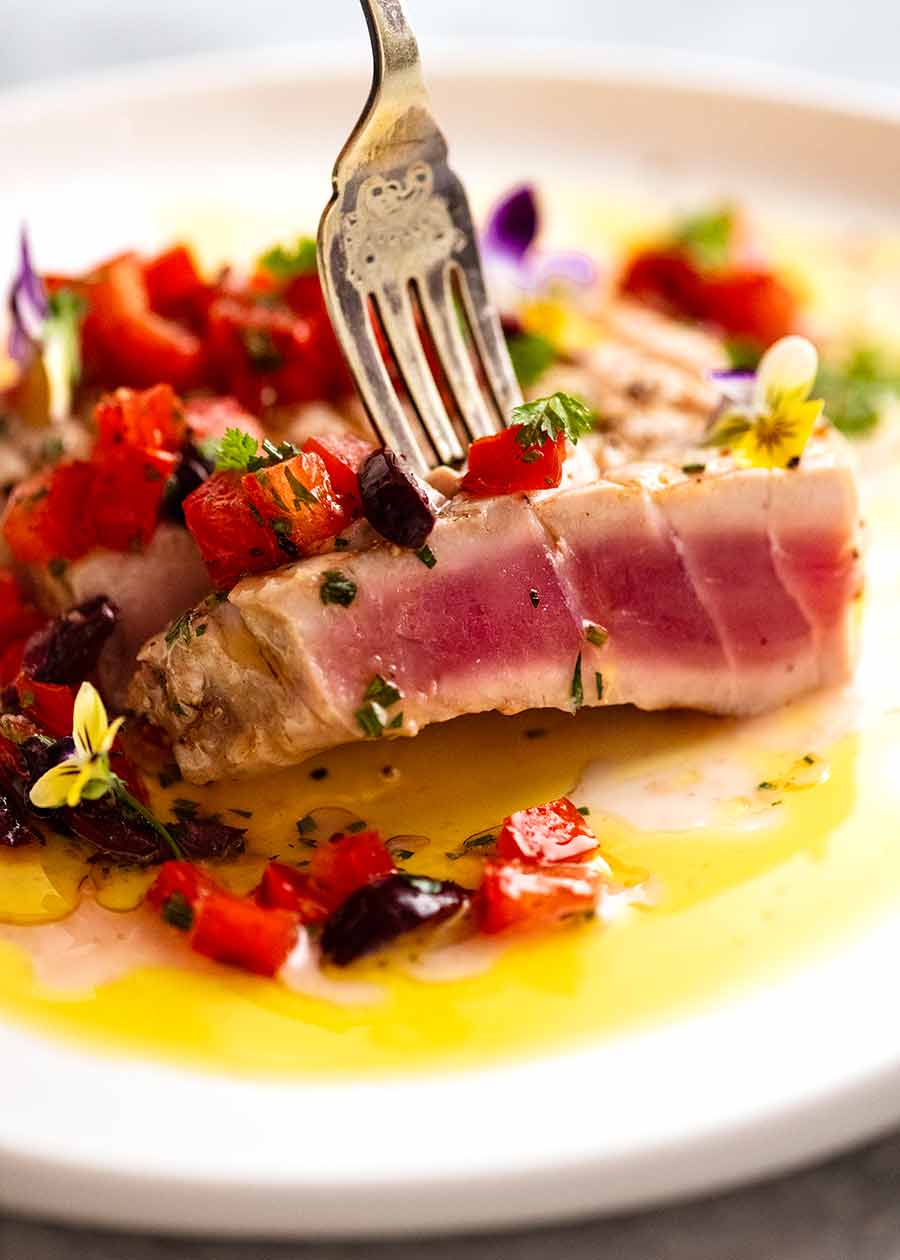
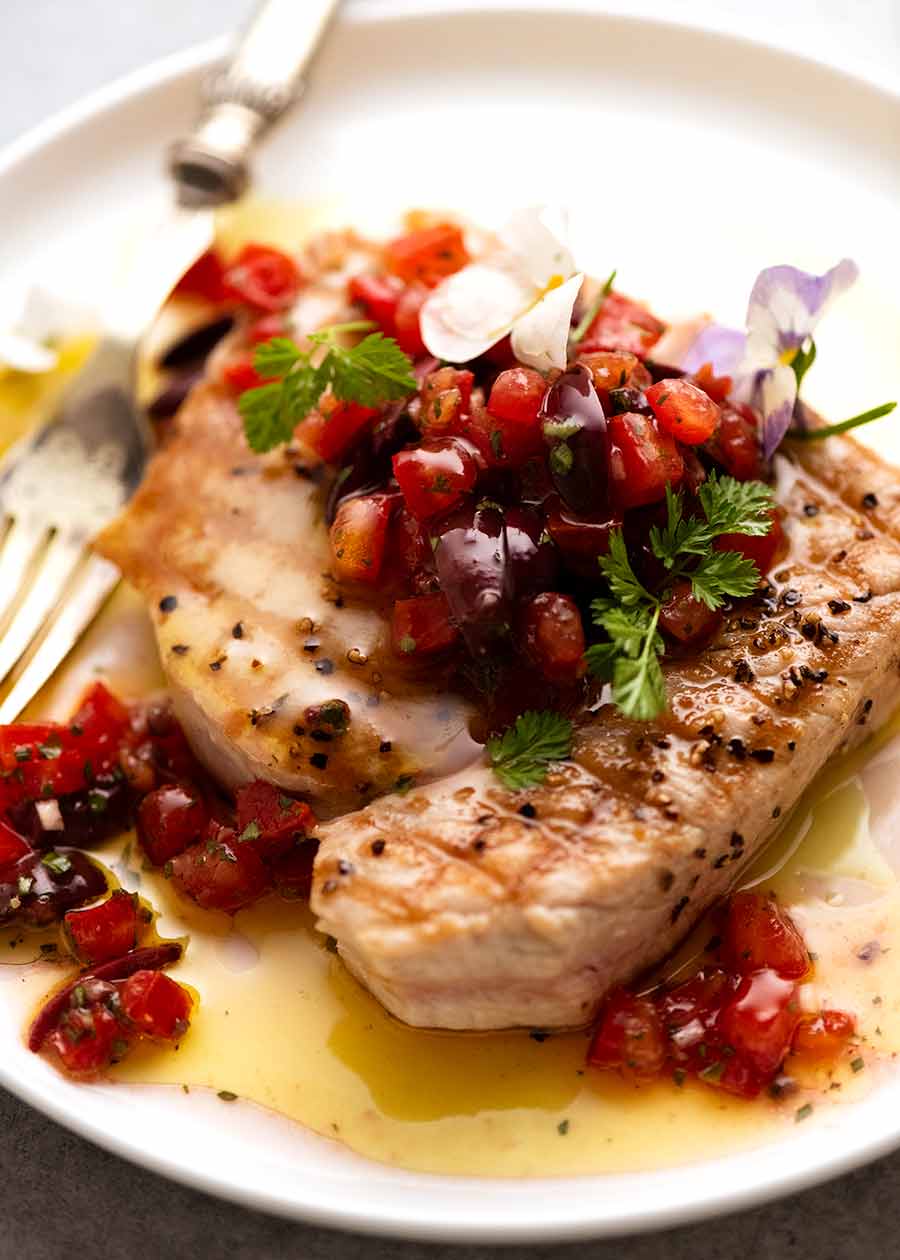
Tuna Steak
There’s a reason why tuna is so highly prized by the most elite restaurants around the world. The belly is sought after for its rich and fatty flesh, while the loins – which we’re using today – have a silky texture and a savoury, clean flavour that isn’t at all “fishy”. The jewel-like hue of the loin meat meanwhile is beautiful and the basis for many a stunning-looking dish.
You’ll often see tuna loin used raw for delicate canapés and starters such as tataki, carpaccio, tartare and ceviche, to name a few. The belly meanwhile is coveted especially for sashimi. Tuna is the star of the world-famous daily tuna auction at the Tokyo fish markets, where whole tuna can sell for mind-boggling prices. (The first bluefin tuna of the season is especially known for drawing outrageous bids for the publicity, and the current record stands at over $3 million for a 278 kg (612 lb) tuna – that’s over $10,000 / kg!!! 😳😳😳)
Such is the appeal and demand for quality tuna today. But ordinary folk like you and me don’t need to pay crazy prices for tuna for our purposes today!! Good quality, fresh tuna steaks are readily available from your local fish monger and are just fine!!
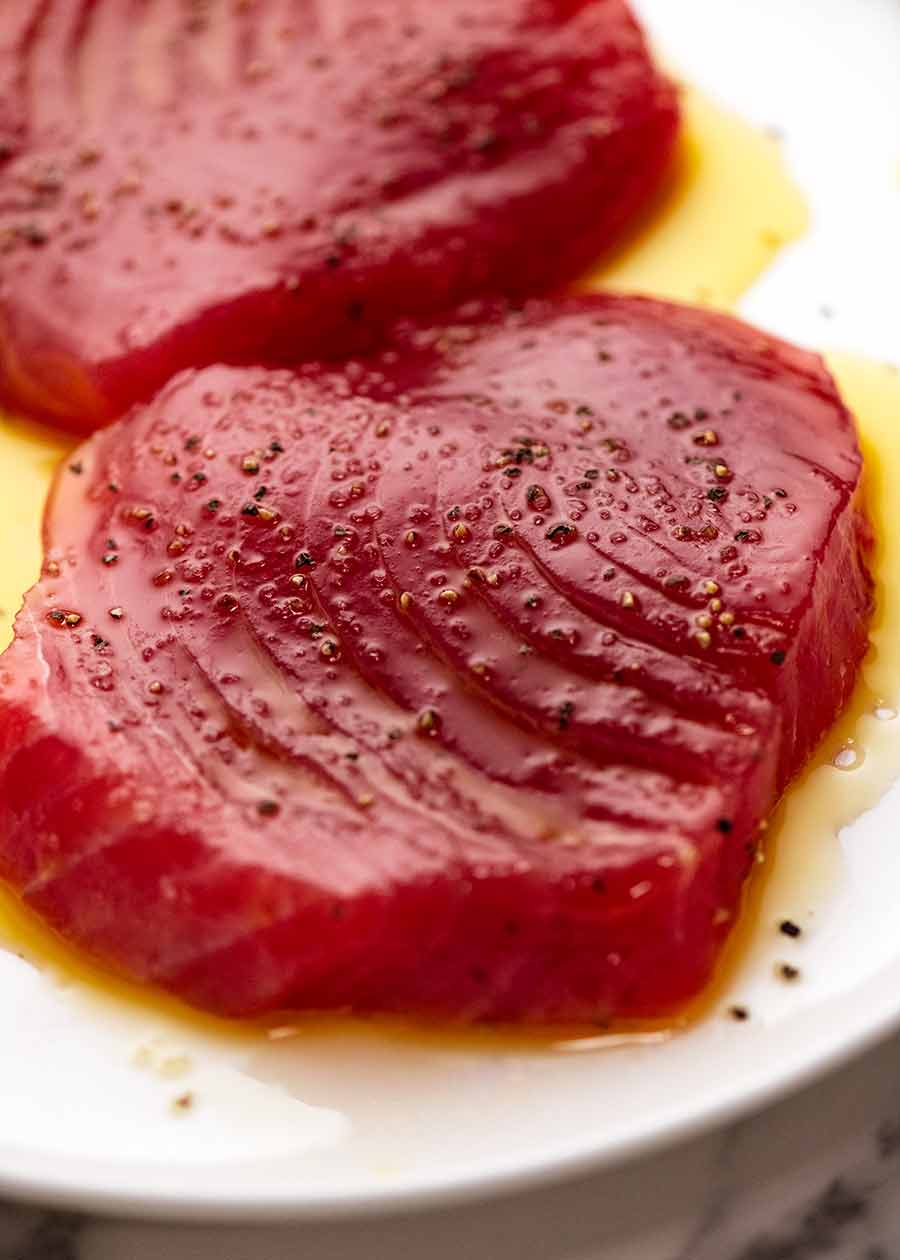
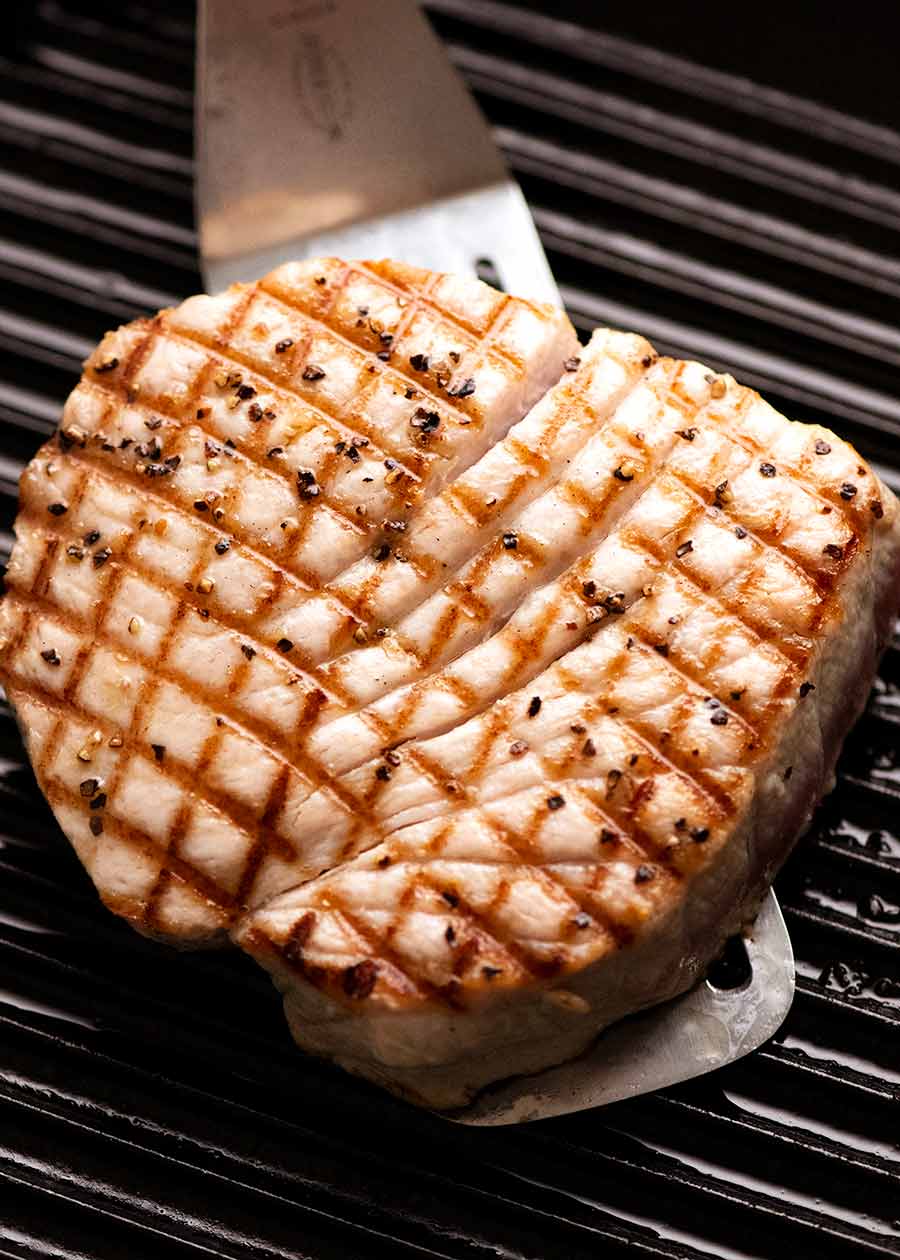
Should tuna steak be raw in the middle? Yes!
If you’re wondering if tuna steak should be raw in the middle, the short answer is YES. A properly cooked tuna steak should be seared on the outside but raw on the inside.
This is because tuna steaks are cut from the loin of the fish. This part of the tuna, identifiable by its even, translucent pink or red colour with little fat, is lean. Once cooked, it tends to become quite dry – think of canned tuna and the texture it has. It’s a bit like overcooked chicken breast! As much as we love our canned tuna, we don’t want to eat a whole steak of that!
Serving the tuna with a rare (raw) centre ensures the inside remains tender and succulent. Tuna that is medium or well done will start to resemble our friend the canned tuna – except without the canning oil that conveniently makes up for that dryness!
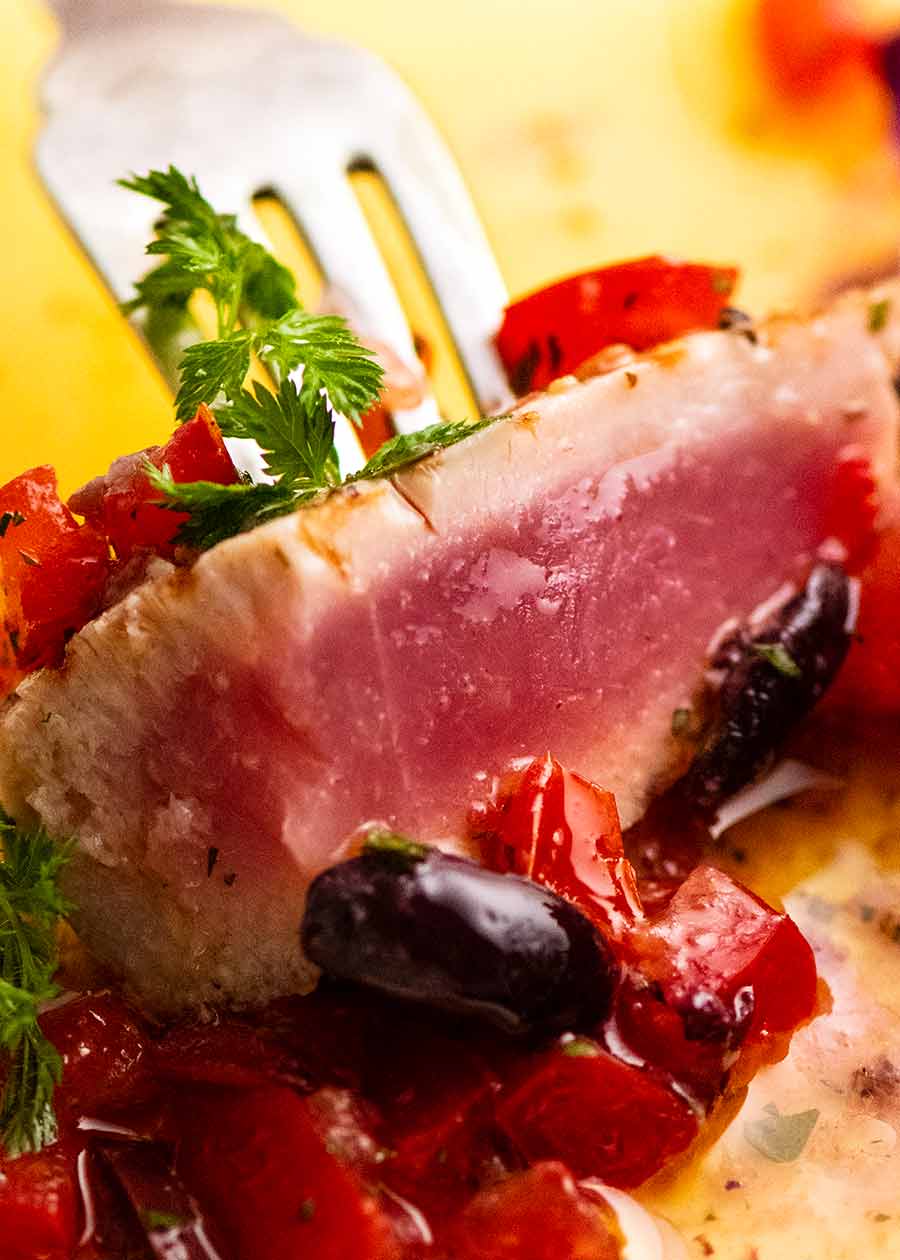
Different varieties of tuna
Different types of tuna have different qualities and culinary uses. Pictured in today’s recipe is yellowfin tuna which is the most common type of tuna sold at fish mongers here in Australia. It’s an excellent all-rounder tuna with a mild flavour, used for everything from sashimi / raw to canning.
The other main types of tuna you might come across are:
Skipjack tuna – Most commonly used for canned tuna, it has a stronger taste than other types;
Albacore tuna – Also used for canning; light coloured flesh;
Bluefin tuna – The most highly prized tuna for its rich flesh and eating qualities, especially by the Japanese. This is the type that sells for mind-boggling prices at the famous Tokyo tuna auctions;
Bigeye tuna – Another highly valued tuna, the second most expensive after bluefin tuna; and
Ahi tuna – This is a Hawaiian name covering both yellowfin and bigeye tuna. People in the US know it for things like Poke Bowls.
What you need to cook tuna steak
Here’s all you need to cook tuna steak: fresh tuna, salt, pepper and oil. (Let’s pretend I didn’t forget the oil in my photo, despite being one of just three ingredients! 😂)
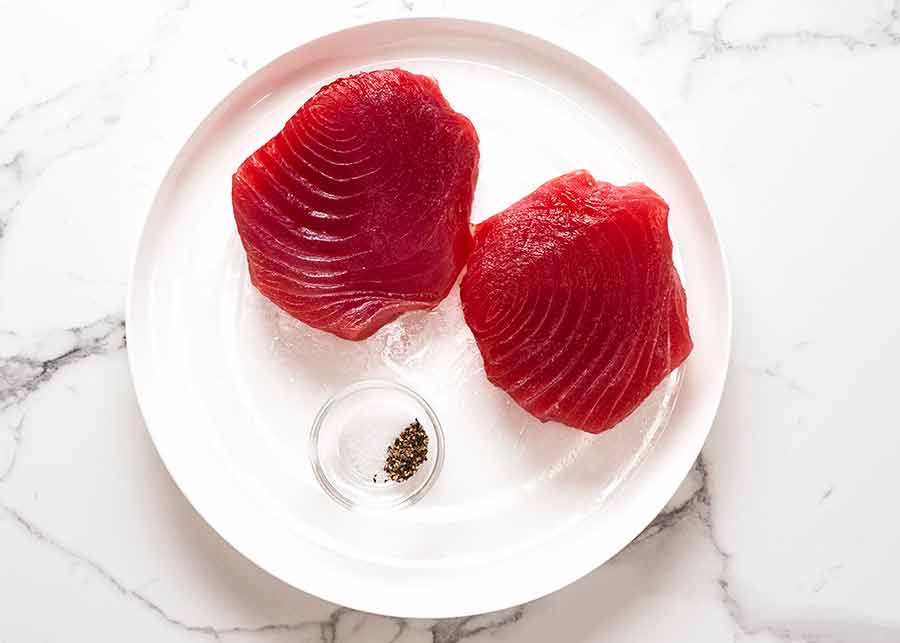
Choosing tuna steaks
Because tuna steak is best served rare inside, it’s important to ensure the tuna is fresh. It doesn’t need to be “sashimi-grade”, which is the quality required when serving the tuna entirely raw, such as with Poke Bowls, Ceviche, Tartare or as sashimi and sushi (the last two recipes are on my mother’s website, RecipeTin Japan). However, it does need to be very fresh.
And it’s super-easy to tell – just smell and touch it:
How to tell tuna steak is fresh
Smells clean like the ocean and not “fishy”; and
Flesh is moist but not slimy.
Trust me, you will know as soon as you smell it if it is fresh – or not! (PS There is absolutely no shame at all in asking the fishmonger to pass the tuna over the counter so you can smell it. I personally insist on it. Fish is expensive!)
How to cook tuna steak
The trick to cooking tuna steak perfectly is a screaming hot skillet so you can sear the outside nicely while keeping the inside raw. It has to be super-hot because it’s only on the stove for 2 1/2 minutes!
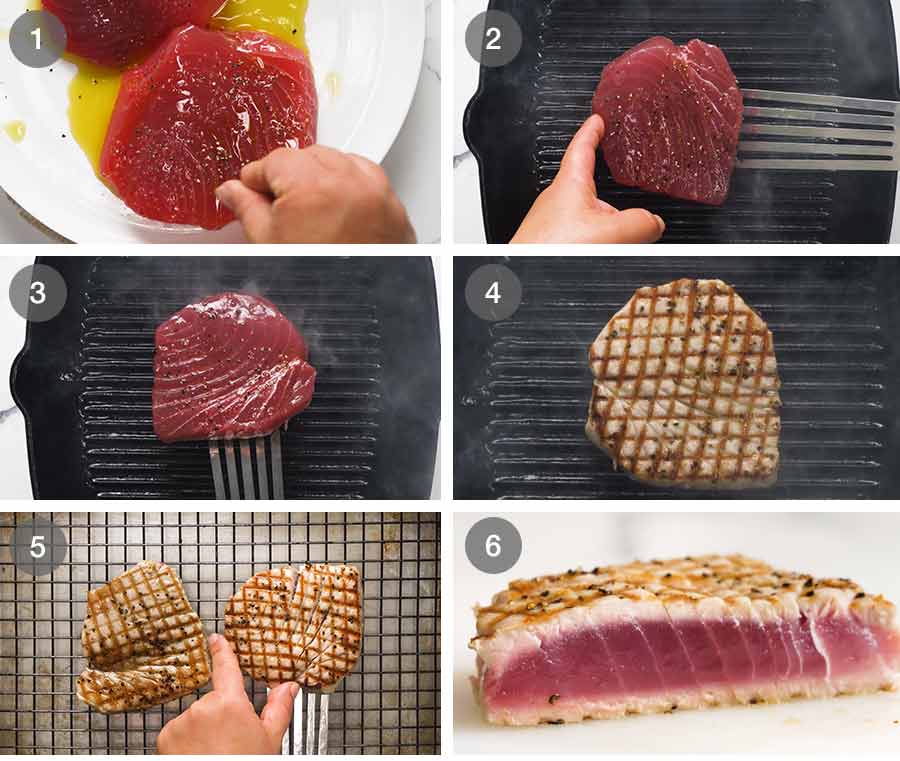
Oil and season steaks – Rub oil on the tuna steak then sprinkle with salt and pepper. I like to use olive oil because it has a bit of flavour, but any oil is fine here;
Preheat skillet until smoking hot – Use a heavy-based skillet so it can be preheated until it’s so hot that you see smoke coming from the pan.
TIPS:
– Do not use a non-stick fry pan. These are not made for high heat cooking and you will ruin the non-stick coating;
– Do not oil the skillet before preheating. It will smoke out your house! If it’s a well-seasoned* cast iron pan or grill pan, as I have used, then there’s no need to add oil into the skillet because we’ve oiled the tuna;
– If you need to oil a skillet (ie. if yours is not a cast iron skillet), wait until it is super-hot then lightly brush with oil. Use either a heat-proof basting brush, paper towel lightly dipped in oil, OR take it off the heat then spray lightly with oil. Never spray a screaming hot skillet with oil ON a gas stove if you value your eyebrows and your house – it’s a fire hazard!!
* A seasoned pan is cast iron or carbon steel pan that has developed a natural non-stick patina through repeated use. It should also be kept lightly oiled to stop it from rusting;Cook tuna – Once the skillet is very hot, place tuna in the skillet.
– How long to cook tuna: A 2.5cm / 1″ thick, 200g / 7oz tuna steak should be cooked for 90 seconds on the first side then 60 seconds on the other side to get a nice sear on the outside while keeping it rare on the inside.
– Target internal temperature: The target internal temperature is 48°C (118°F). This will ensure the inside is still rare and pleasantly warm rather than stone cold;How to get the criss-cross grill marks – If you want to get the fancy restaurant-style grill marks:
a) Use a cast iron grill pan – Use a cast iron skillet with grill Iines, like that pictured in post;
b) Cook 45 seconds – Place tuna in skillet for 45 seconds;
c) Turn 45 degrees, cook another 45 seconds – Turn the tuna 45 degrees and leave for another 45 seconds. Then flip the tuna;
d) 60 seconds other side – Cook tuna steak on second side for 60 seconds, then remove to a rack;You will notice this means the criss-cross is applied to only one side. This is to simplify the cooking. Serve the criss-cross side facing up, obviously!
Tip: For the most perfect lines, do not move the tuna once placed in the skillet (except to rotate the one time)!
Rest on rack – Ordinarily, we want meats to continue cooking as they rest. This is sometimes called “carry over cooking”. In this case, we want to minimise it because we want the tuna steak to remain rare inside! So I like to use a rack set over a tray to rest tuna steak, to encourage excess heat to dissipate. You rarely see me do this, I normally just use a plate (save washing up and all that jazz!) So the fact that I’m doing it tells you that it matters!
Slice up and admire! Let the tuna rest for 5 minutes until cool. The cooler the tuna, the easier it is to slice so the seared crust sets and is less likely to crumble when you cut it. It’s actually better served at room temperature since the middle of the tuna only gets to 48°C/118°F which is rare (barely above raw). If you serve it hot, the temperature difference between the outside and inside can seem jarring when you eat.
Slicing to serve is optional. Fine dining restaurants often choose to pre-slice tuna for presentation purposes, because the striking red colour inside looks so good!
As for what to serve with Tuna Steak? It’s pictured in this post with Sauce Vierge, a kind of French salsa / vinaigrette. This light and bright sauce goes perfectly with fine and fresh-tasting tuna steak. See below for a list of more Tuna Steak sauces and topping ideas!
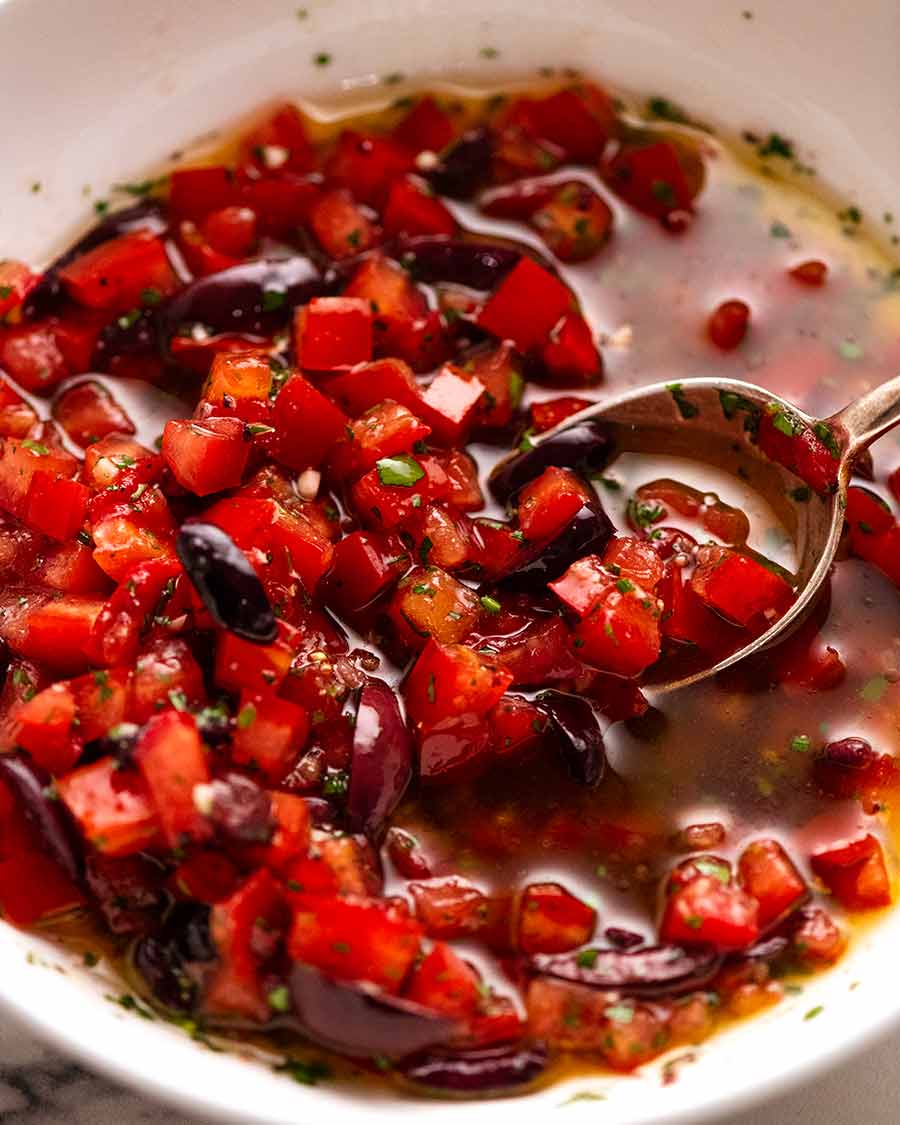
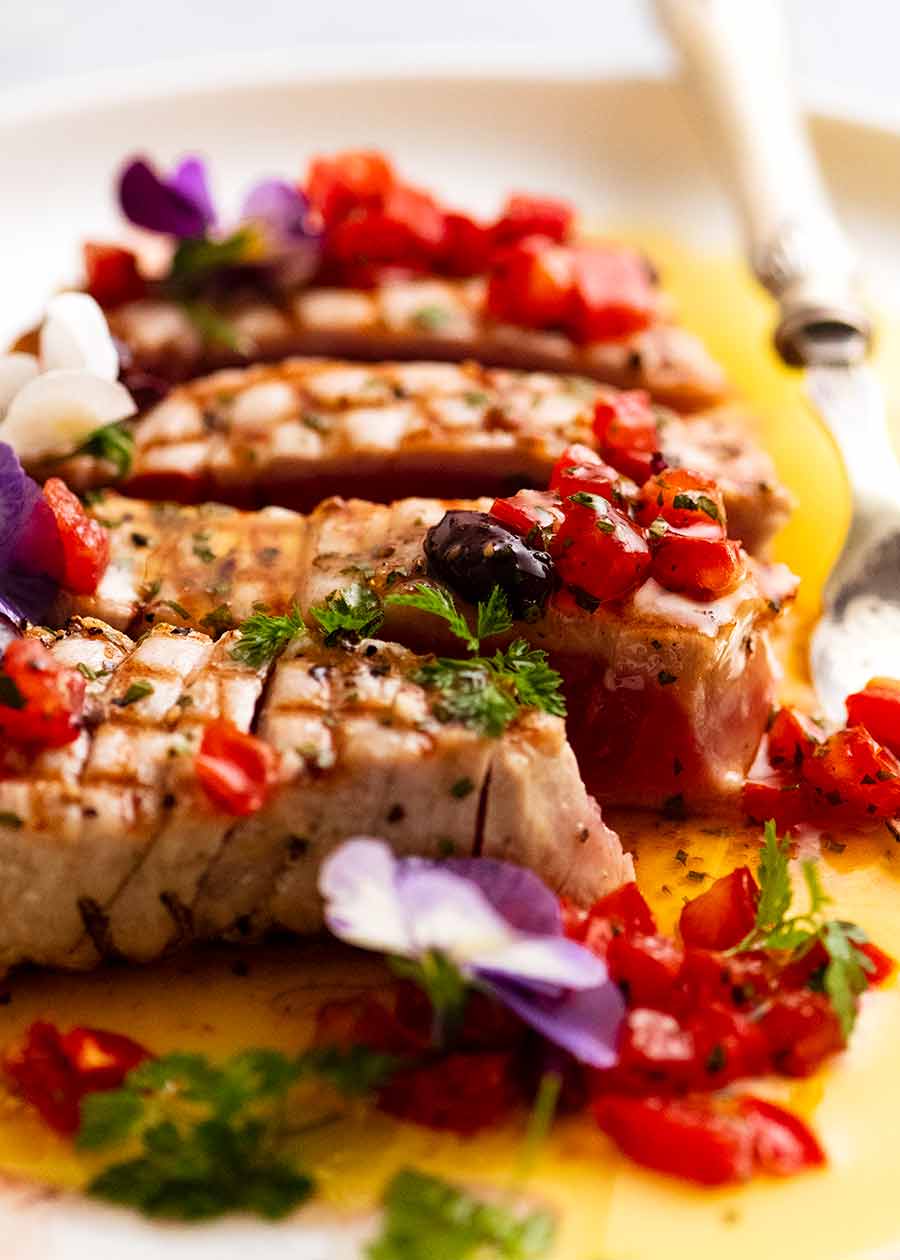
Best sauces and toppings for Tuna Steak
Being a relatively mild flavoured fish, tuna lends itself for all sorts of possibilities when it comes to a sauce. Bright and fresh sauces and accompaniments work best with this tuna, rather than very buttery or creamy type sauces (like this Lemon Cream Sauce for Fish).
Here are some suggestions:
Sauce Vierge – Pictured in the post, this is a summery French salsa / vinaigrette popularised by the great French chef, Michel Guérard. He is known for introducing a lighter style of French food emphasising simplicity and freshness, influences we still see in restaurants today. This sauce pairs beautifully with tuna. I especially enjoy how the vinaigrette seeps into the cracks of the tuna flakes when you spoon it over;
Mexican salsa – The bright, jumping flavours of a Mexican tomato salsa would also be wonderful with tuna! Casually dollop it over like I’ve done with the Sauce Vierge. Pico de Gallo would also work, though I’d recommend chopping the tomato a little smaller;
Salsa Verde – Beautiful, fresh herbs in this simple, no-cook, pesto-like sauce make this ideal for tuna and all types of seafood, not mention its gorgeous dazzling green colour!
Pesto – A smear of basil pesto on the side would be terrific. You won’t need much because the flavour of pesto is more intense than, say, Salsa Verde;
Chimichurri Sauce – South America’s contribution to the world of zingy, meat-friendly sauces, this parsley-garlic-olive oil sauce is a great choice for tuna;
Japanese Ginger Sauce – If you’re looking for a Japanese bent, use the marinade/sauce in my Tuna Poke Bowl recipe. It’s fabulous!
Lemon Vinaigrette – The zippy taste of lemon is a natural pairing with any fish! Using a vinaigrette (ie. salad dressing) instead of plain lemon juice. The oil and other flavours adds some richness and extra taste. It also makes the dressing more viscous so it clings to the tuna better. Use the dressing in this Brown Rice Salad recipe.
There’s just a few ideas to get you started! 😉
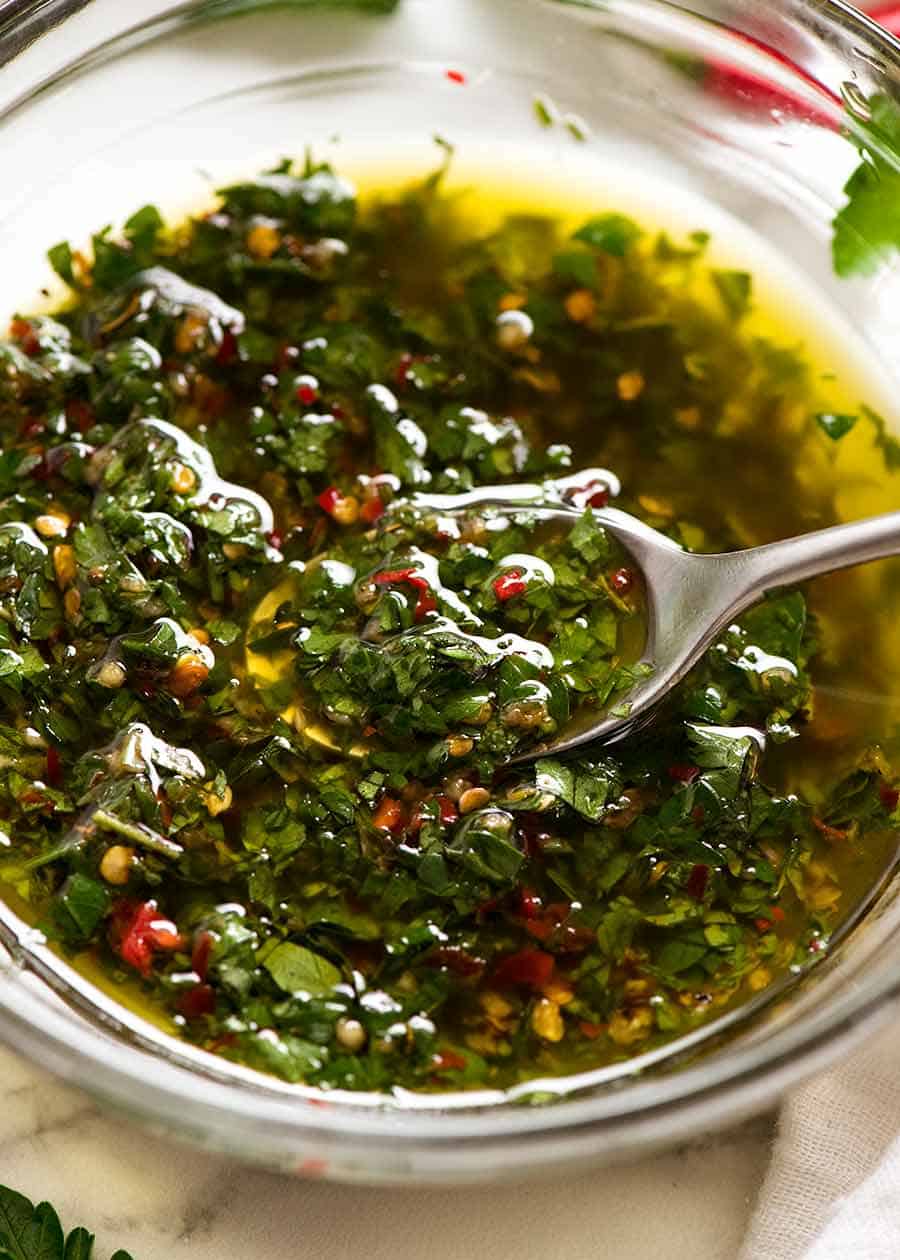
Chimichurri sauce 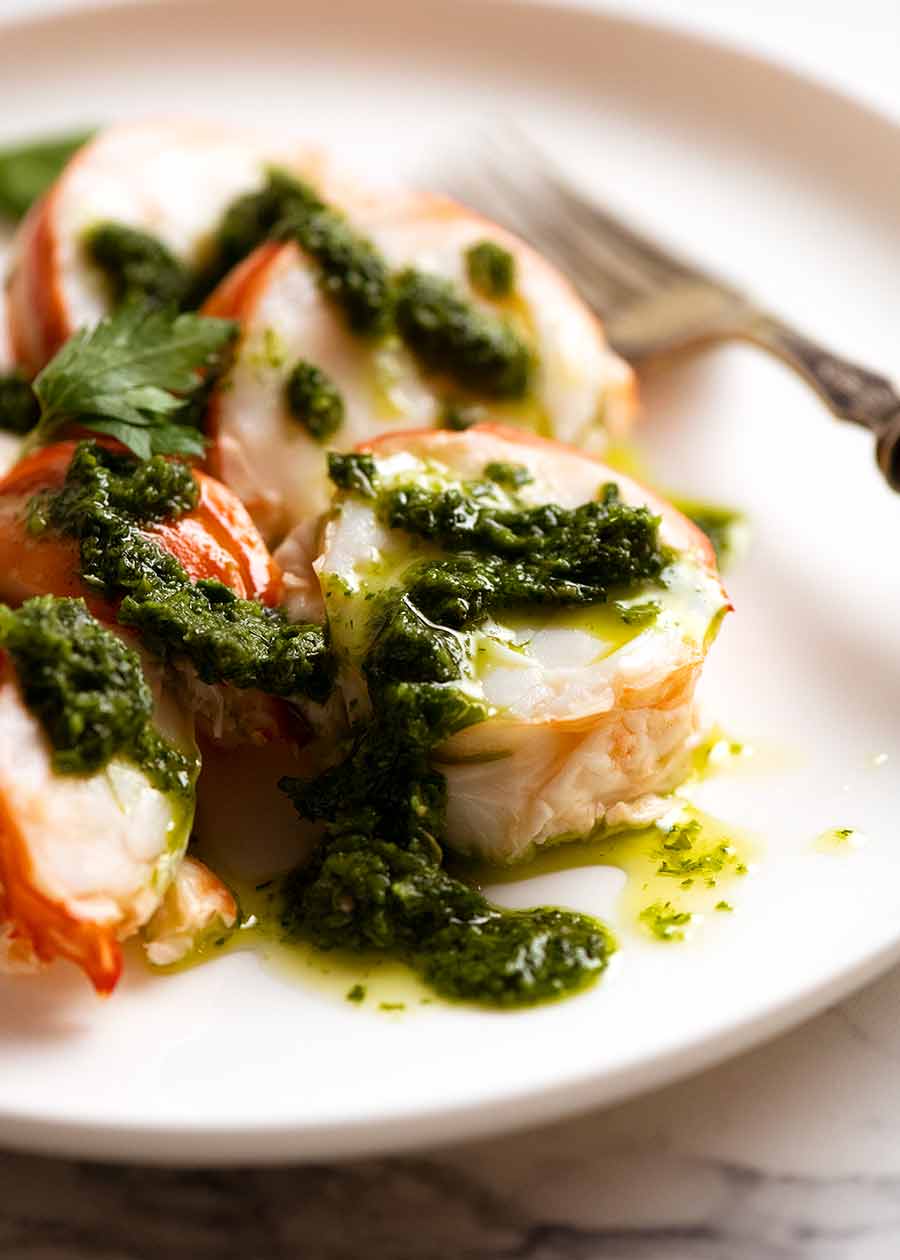
Salsa Verde (pictured with lobster) 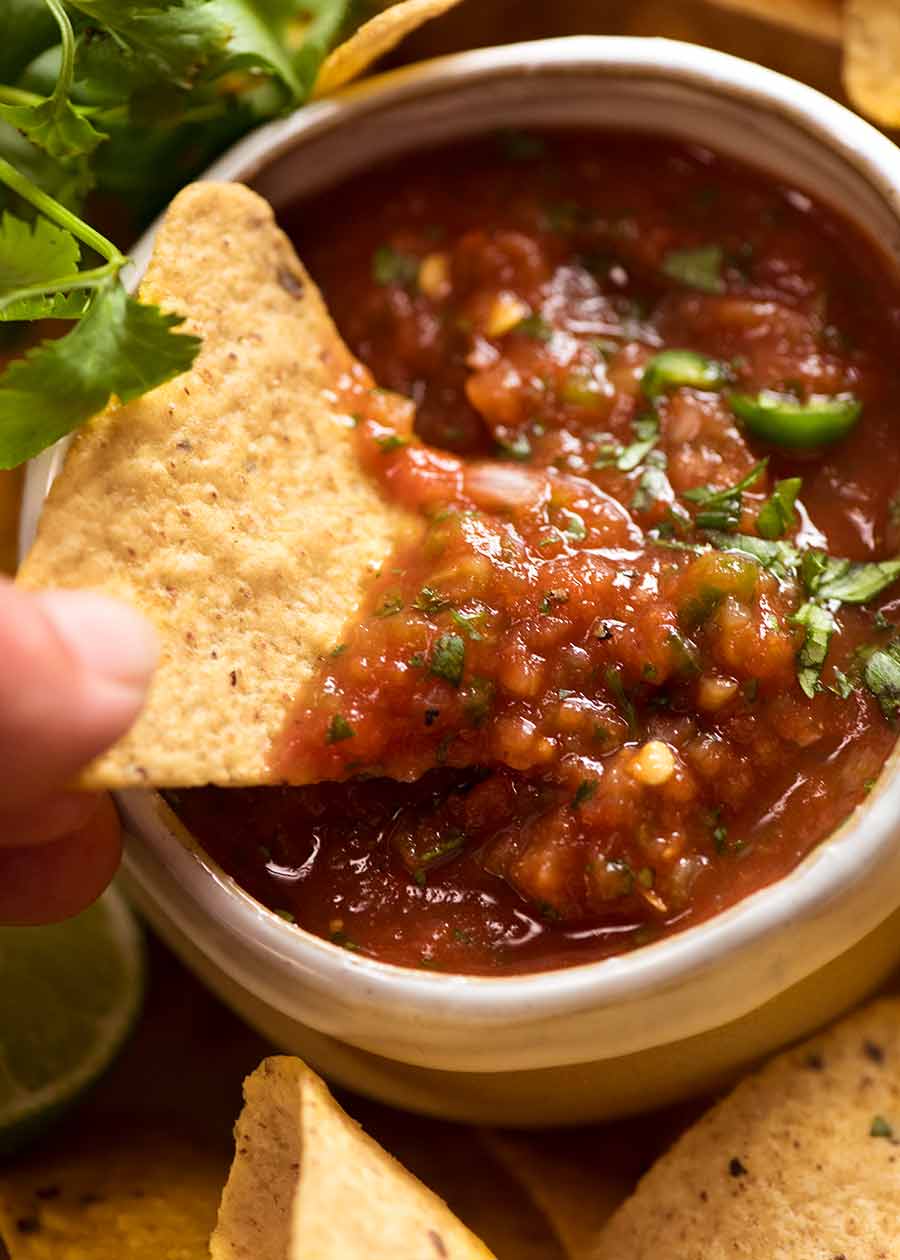
Mexican Salsa 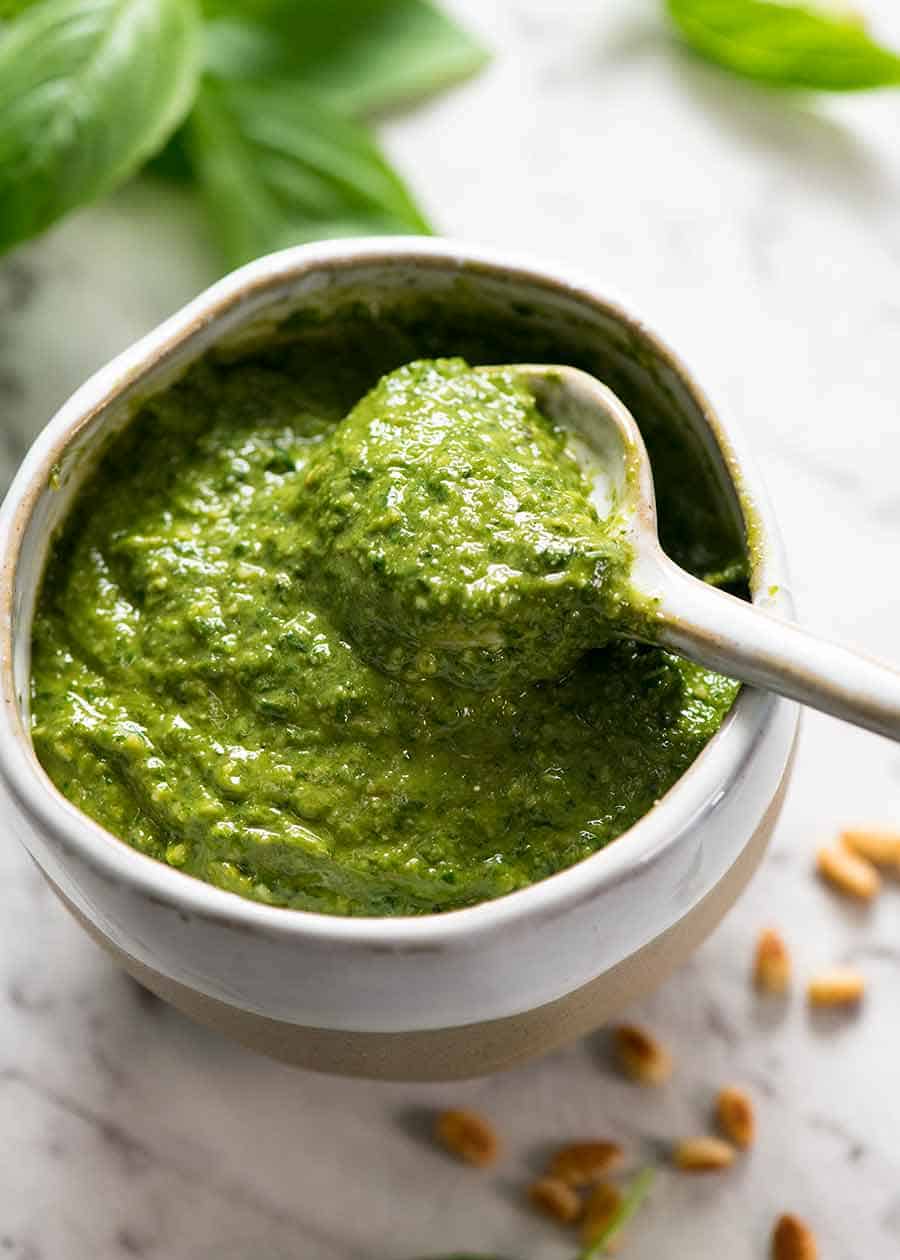
Pesto
Sides to serve with Tuna Steak
As for sides, it really depends which way you go with the flavours. Generally I’d opt for lighter sides to keep with the fresh vibe of the tuna and sauces. Here are some suggestions:
Marinated Vegetable Pasta Salad – A great veg + starch side option. Or try this Mediterranean Brown Rice Salad else Wild Rice Salad;
White Bean Tabbouleh Salad – All the flavours you love about tabbouleh, bulked out with beans to make a all-in-one side;
Homemade (super easy!) crusty artisan bread + a leafy green salad with a French, Italian or classic Salad Dressing;
A big fat Green Bean Avocado Salad!
Scrolling back through everything I’ve written, this seems like an unusually long post for a recipe that supposedly takes 2 1/2 minute flat to cook! 😂
Truthfully, I just want you to feel confident when you decide to try this recipe. So I have walked through all the information I thought you might want to know, even if you’ve never cooked tuna steak before.
I hope you find it useful, and more importantly that it looks so delicious that you can’t resist giving it a go! Remember, tuna steak is:
✔ Healthy – Low fat, low calories, high protein, and contains essential amino acids
✔ A unique and delicious fish
✔ Fine dining-worthy, but still affordable and can be done at home!
– Nagi x
Watch how to make it
Hungry for more? Subscribe to my newsletter and follow along on Facebook, Pinterest and Instagram for all of the latest updates.
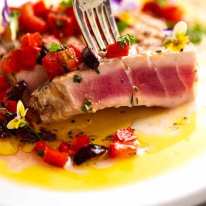
Tuna Steak
Ingredients
- 2 x 180 – 200g (6.5 – 7oz) tuna (skinless, boneless). 2.5-3cm / 1-1.2" thick (Note 1)
- 1 tsp olive oil
- 1/4 tsp sea salt
- 1/8 tsp black pepper
Cooking:
- 2 tsp olive oil , or oil spray
Serving suggestion (Note 2):
- Sauce Vierge (French salsa / vinaigrette for fish)
- Chervil sprigs (substitute small flat leaf or curly parsley leaves) or small edible flowers (optional)
Instructions
- Prepare resting tray: Place a rack on a tray. (Note 3)
- Oil and season tuna: Drizzle half the oil over the tuna. Smear over one side, then sprinkle with half the salt and pepper. Flip and repeat.
- Heat skillet: Heat skillet (preferably a skillet with grille lines) over high heat until smoking hot. The hotter, the better!
- Oil skillet (if required): If your skillet is not well-seasoned, brush skillet with olive oil or take pan off stove and spray with any oil (SAFETY WARNING! Note 4)
- Cook first side: Place tuna steak in the skillet (I do one at a time for best results, Note 5) and cook for 45 seconds.
- Rotate for grill lines: Turn steak 45 degree. Continue cooking another 45 seconds.
- Cook other side: Flip tuna carefully, then leave for 1 minute or until the internal temperature in the middle reads 48°C / 118°F (Note 6).
- Rest: Remove tuna from skillet and place on rack. Rest for 5 minutes – it will cool down almost to room temperature. This is desirable for easier slicing and better eating (Note 7) Serve! See Note 2 for sauce options.
Plating up – with Sauce Vierge option (pictured):
- Slice, if desired (Note 7): Place tuna on a board with criss-crossing grill lines facing up. Slice the tuna into 4 or 5 thick slices, holding the edges with your fingers as needed to ensure the seared surface doesn't crumble. Transfer to serving plate and separate the slices slightly so they insides are just visible, or on an a slightly angle, overlapping each other.
- Sauce Vierge: Spoon the Sauce Vierge over steaks, leaving small piles of tomato here and there on the tuna slices, and a few on the plate. Other sauce options: See Note 2.
- Finishing: Drizzle with a bit of olive oil. It looks beautiful as it is, but if you want to raise the bar even higher, add a few small sprigs of chervil and some edible flowers!
Recipe Notes:
- Buying – Tuna comes cut into steaks, rather than thin fillets you traditionally see with white fish
- It is almost always sold skinless and boneless
- A meat thermometer highly recommended – Tuna can go from perfectly rare inside to medium in the space of 30 seconds so the use of a meat thermometer is highly recommended.
- Steak size and cook times – The cook times specified in this recipe are for a 180g (6.5oz) tuna steak that is 2.5cm (1″) thick.
- Thickness of tuna steak also plays a big part in cook time.
- Mexican salsa – The bright flavours of a Mexican tomato salsa would be wonderful with tuna! Casually dollop it over;
- Pico de Gallo – Chopping the tomato a little smaller;
- Salsa Verde – A beautiful, fresh herb taste and gorgeous dazzling green colour!
- Pesto – A smear of basil pesto on the side would be terrific. Use sparingly as its strong;
- Chimichurri Sauce – This South American parsley-garlic-olive oil sauce is a great choice for tuna;
- Japanese Ginger Sauce – Use the marinade/sauce in my Tuna Poke Bowl recipe. It’s fabulous!
- Lemon Vinaigrette – Any vinaigrette is a natural pairing with any fish! Try the dressing in this Brown Rice Salad recipe. You can also optionally gently warm a vinaigrette for serving.
Nutrition Information:
Life of Dozer
Doggie paddle race!! Guess who won??


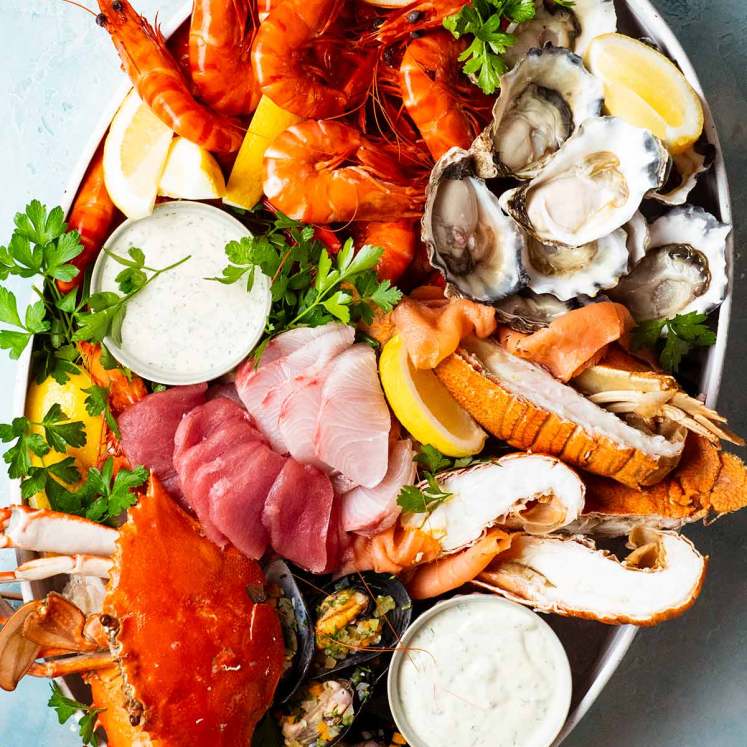

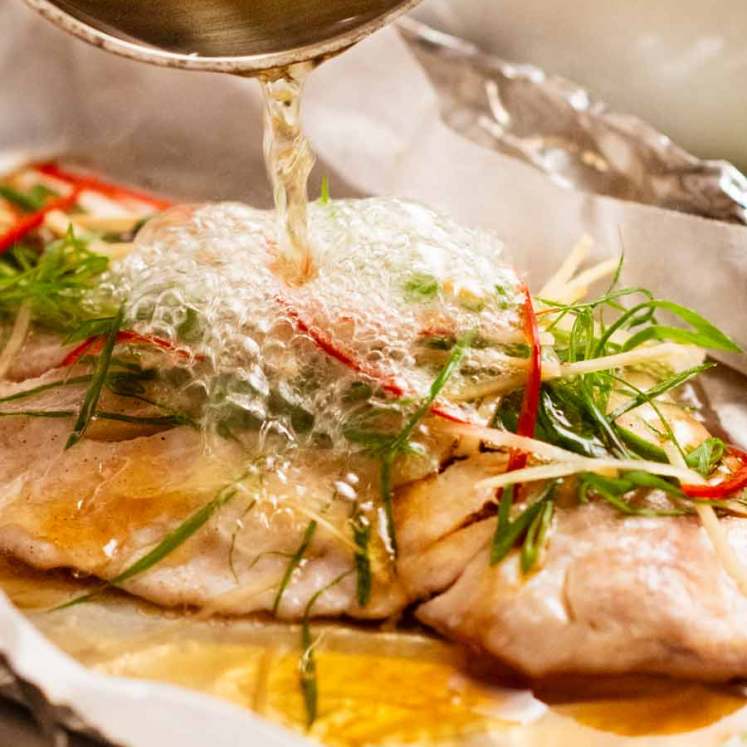
Instructions result in perfectly cooked Tuna, and the Sauce Vierge complements the fish so well.
Beautifully written instructions for seared tuna. I make this often with Ahi in Hawaii. Serve it with tropical salsa and your perfect coconut rice! Ono!!!!
Oops! Forgot to put 5 stars! Wish I could give 6!
Excellent!
For easter dinner, we were just the two of us, we had the tuna with the Sauce vierge and the lemony potato salad. Everything tasted so fresh, beautiful easy recipes. I ordered your cook book. Thank you,
Thank you so much for this recipe! At the grocery store, they had ahi tuna steaks on sale, so I looked up this recipe on your blog and decided to buy them. I made them with the lemon vinaigrette, and I can’t believe how easy and delicious they were. I will definitely make these again (though I usually make everything I try from you blog again!). Thanks for your amazing recipes, and please do a book tour in the US!
I bought some frozen ahi tuna steaks that say on the bag to cook to a minimum 165 degrees Fahrenheit. Does this usually mean the tuna isn’t safe to eat rare?
Fish need not be cooked at all, if it has been frozen for a while. The freezing kills off the bad stuff, if it has been professionaly handled. Think Japanese sushi (raw fish). But you must still use common sense; don’t thaw the fish at room temperature, serve it as you make it (cannot prepare ahead of time), etc.
Super super super! My family just loved it! Thanks a lot of an awesome recipe. Big fan of all ur recipes. Keep posting new ones. Can wait to try them all.
Perfect recipe and instructions! We made Sauce Vierge with it, but as a whole salad instead of just a sauce. Delicious! Thank you Nagi, your recipes are the best!
Lady looked at me like I had 4 eyes when i asked to smell the tuna 😜 (maybe its because of covid times), i agree there shouldnt be any shame when asking to smell a piece of quality meat before you buy it, but it was an unwelcome request here in Colorado, so i opted for salmon, gonna try this recipe when i get back to the east coast!
Any decent fish seller understands perfectly when customers ask to smell fish before purchasing. If not, I would shop elsewhere. I always sniff first.
Love your recipes! Thanks for sharing. Hi to Dozer! I found your blog when I searched for dog birthday cakes.
Looks tasty!
Nagi!
I would love the recipe for the Japanese ginger sauce!! Please! Thanks so much!! Hugs for Dozer!
Hi Penny, click the link through to the marinade on the tuna poke bowl! You’ll love it! N x
I’ve always wanted to try cooking tuna but didn’t know the best way to use it. Thank you for answering all my questions!! Lovely photos by the way!
You’re so welcome Alice, I hope you try this one and love it!! N x
Nagi!! I was so excited to see this email with the Tuna Steak recipe!! Thank you, thank you, thank you!! I ate it at a restaurant and fell in live with it! I’ve never been able to find a recipe like it, but this is it!! The sauce the restaurant served it we it was a soy reduction with pieces of “pickled” ginger on the side. You’ve nailed it and answered all my questions. Plus I always wanted to try a tuna poke bowl and got your Mom’s recipe with this email! I enjoy your recipes, stories and of course Dozer!! I am searching for a golden retriever puppy right now actually. I can’t wait to find one!! Keep those recipes coming! Again, I enjoy you so much!!
That’s so lovely to hear – thanks so much Karbel!!! PLEASE send me a picture once you find your puppy!! I love puppy spam!! N x
Been trying to find Tuna fish steak here in Finland for ages…(Considering I live in a seaside town, it’s a bit ridiculous!) Perseverance – I shall succeed!
It’s about as rare as lamb.
PS – any reindeer recipes? Reindeer (poro) are the Finnish equivalent to sheep – just as plentiful.
Well that’s annoying isn’t it Andy, what kind of seafood do you get over there. Sorry no reindeer recipes – finding that would be an absolute mission here! N x
Am smiling about the request for reindeer recipes – and I was born in Estonia ! C’mon – how many in the world would have access to such ? ! I grew up on ‘lamb soup’ and somewhat boring roasts and whatever . . . and I am sorry you cannot access tuna where you live . . . most can . . .
Unfortunately, tuna is on our red list here in RSA.
ALL species of tuna? Or is this a fudge?
Oh no! Sorry to hear that Clyde! N x
I love your posts and you. But have to admit Dozer is my favourite. Sorry! And I am a cat person.
I always knew he’d steal the show Lindie!! N x
Yes ! Absolute perfection for a perfect dish ! Some of the best photography I have seen coming from your stable . . . I’ll have it with steamed baby potatoes and the Japanese ginger sauce . . .
Thanks so much Eha!!! N x